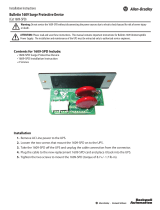
17
Safety Information - SAVE THIS GUIDE
This Safety Guide contains important instructions that should be followed during installation and maintenance of the
equipment and batteries. It is intended for customers who setup, install, relocate, or maintain equipment.
Changes and modifications to this unit not expressly approved could void the warranty.
Handling Safety
<18 kg (<40 lb) 32–55 kg (70–120 lb)
18–32 kg (40–70 lb) >55 kg (>120 lb)
>10º
CAUTION! Electrical Safety
• Do not work alone under hazardous conditions.
• High current through conductive materials could cause severe burns.
• Check that the power cord(s), plug(s), and sockets are in good condition.
• Use qualified service personnel to change the plug on the UPS and to install permanently wired equipment.
• When grounding cannot be verified, disconnect the equipment from the utility power outlet before installing or
connecting to other equipment. Reconnect the power cord only after all connections are made.
• Do not handle any metallic connector before the power has been disconnected.
• Connect the equipment to a three wire utility outlet (two poles plus ground). The receptacle must be connected to
appropriate branch circuit/mains protection (fuse or circuit breaker). Connection to any other type of receptacle may
result in risk of electrical shock.
• 230 V models only: In order to maintain compliance with the Electro Magnetic Compliance directive for products sold in
Europe, output cords attached to the UPS should not exceed 10 meters in length.
• 230 V models only: Total leakage current from connected equipment and the UPS must not exceed 3.5 mA for a
pluggable A Type UPS.
CAUTION! Deenergizing Safety
• If the UPS has an internal energy source (battery), the output may be energized when the unit is not connected to a utility
power outlet.
• To deenergize a pluggable UPS, press the OFF button or switch to shut the equipment off. Unplug the UPS from the
utility power outlet. Disconnect the external batteries where applicable and disconnect the internal battery (see User
Manual). Push the ON button to deenergize the capacitors.
To deenergize a permanently wired UPS, press the OFF button or switch to shut the equipment off. Switch off the
utility circuit breaker that supplies power to the UPS. Disconnect the external batteries where applicable and disconnect
the internal battery (see User Manual).
WARNING! Battery Safety
• This equipment contains potentially hazardous voltages. Do not attempt to disassemble the unit. The only exception
is for a UPS containing batteries. Refer to the battery replacement procedures detailed in the User’s Manual. Except for
the battery, the unit contains no user serviceable parts. Repairs are to be performed only by qualified service
personnel.
• Do not dispose of batteries in a fire. The batteries may explode.
• Do not open or mutilate batteries. They contain an electrolyte that is toxic and harmful to the skin and eyes.
• To avoid personal injury due to energy hazard, remove wrist watches and jewelry such as rings when replacing the
batteries. Use tools with insulated handles.
• Replace batteries with the same number and type of batteries as originally installed in the equipment.
Replacement and Recycling of Batteries
See your dealer or contact Rockwell Automation at 440-646-5800, for information on replacement battery kits and battery
recycling.
Be sure to deliver the spent battery to a recycling facility in the replacement battery packing material.
41063-260-01(1)


















